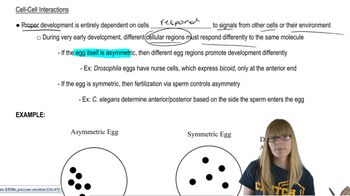During early development, human cells determine their differentiated fates based on the environment. What term describes this phenomenon?
Table of contents
- 1. Introduction to Genetics51m
- 2. Mendel's Laws of Inheritance3h 37m
- 3. Extensions to Mendelian Inheritance2h 41m
- 4. Genetic Mapping and Linkage2h 28m
- 5. Genetics of Bacteria and Viruses1h 21m
- 6. Chromosomal Variation1h 48m
- 7. DNA and Chromosome Structure56m
- 8. DNA Replication1h 10m
- 9. Mitosis and Meiosis1h 34m
- 10. Transcription1h 0m
- 11. Translation58m
- 12. Gene Regulation in Prokaryotes1h 19m
- 13. Gene Regulation in Eukaryotes44m
- 14. Genetic Control of Development44m
- 15. Genomes and Genomics1h 50m
- 16. Transposable Elements47m
- 17. Mutation, Repair, and Recombination1h 6m
- 18. Molecular Genetic Tools19m
- 19. Cancer Genetics29m
- 20. Quantitative Genetics1h 26m
- 21. Population Genetics50m
- 22. Evolutionary Genetics29m
14. Genetic Control of Development
Studying the Genetics of Development
Problem 2
Textbook Question
Write a short essay based on the concepts related to stages of development that outlines the role of differential transcription, gene control of cell fate, and the role of signaling systems in development.
 Verified step by step guidance
Verified step by step guidance1
Begin by explaining the concept of differential transcription. Describe how specific genes are turned on or off in different cells, leading to the production of distinct proteins that define cell identity and function. Highlight the importance of transcription factors and epigenetic modifications in regulating gene expression.
Discuss gene control of cell fate. Explain how certain genes act as 'master regulators' to determine the developmental pathway of a cell. Provide examples, such as the role of Hox genes in patterning body structures, and emphasize the importance of precise gene regulation in ensuring proper development.
Introduce the role of signaling systems in development. Explain how cells communicate with each other through signaling pathways, such as the Notch, Wnt, and Hedgehog pathways, to coordinate growth, differentiation, and spatial organization. Highlight the importance of signal transduction in responding to environmental cues and guiding developmental processes.
Connect the three concepts by describing how differential transcription, gene control of cell fate, and signaling systems work together to orchestrate development. For example, explain how signaling pathways can activate transcription factors that regulate gene expression, ultimately influencing cell fate decisions.
Conclude by emphasizing the significance of these mechanisms in development and their implications for understanding diseases caused by developmental errors, such as cancer or congenital disorders. Suggest how studying these processes can lead to advancements in regenerative medicine and genetic therapies.
 Verified video answer for a similar problem:
Verified video answer for a similar problem:This video solution was recommended by our tutors as helpful for the problem above
Video duration:
3mPlay a video:
Was this helpful?
Key Concepts
Here are the essential concepts you must grasp in order to answer the question correctly.
Differential Transcription
Differential transcription refers to the process by which specific genes are expressed at different levels in various cell types or developmental stages. This selective gene expression is crucial for cellular differentiation, allowing cells to acquire unique identities and functions. By regulating which genes are transcribed, cells can respond to internal and external signals, shaping their roles in the organism.
Recommended video:
Guided course

Eukaryotic Transcription
Gene Control of Cell Fate
Gene control of cell fate involves the mechanisms by which specific genes determine the developmental pathways that cells will follow. This process is influenced by transcription factors and epigenetic modifications that activate or silence genes, guiding cells toward particular lineages. Understanding how gene control operates is essential for comprehending how multicellular organisms develop complex structures and functions.
Recommended video:
Guided course

Cell-cell interactions
Signaling Systems in Development
Signaling systems in development consist of various molecular pathways that facilitate communication between cells, influencing their growth, differentiation, and behavior. These systems often involve ligands, receptors, and downstream effectors that transmit signals, leading to coordinated responses during development. Proper functioning of these signaling pathways is vital for ensuring that cells develop correctly and form organized tissues and organs.
Recommended video:
Guided course

Gamete Development

 8:30m
8:30mWatch next
Master Genetics of Development with a bite sized video explanation from Kylia
Start learningRelated Videos
Related Practice
Multiple Choice
353
views
4
rank
